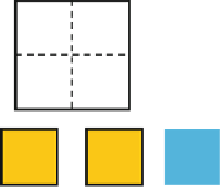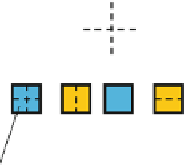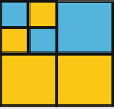Graphics Reference
In-Depth Information
Coding
Tree Unit
(CTU)
Divide into
coding units
(CU) with
quad tree
skip
Divide into
prediction
units (PU)
Asymmetric
Motion Partition
Fig. 8.6
A coding tree unit is subdivided into CUs along the associated coding quadtree. Each
resulting CU may be further subdivided into PUs. The intra-coded CUs are in
blue
while inter-
coded CUs are in
orange
. Note that the figure only shows the corresponding CTB, CBs, and PBs
of the luma component
split_cu_flag
is used instead of
part_mode
to avoid redundant signaling.
For instance, if the minimum CU size is 8
8 in terms of luma samples, a CU
of size 16
16 with four 8
8 PUs is signaled with
split_cu_flag
D
1,
and
part_mode
D
PART_2Nx2N rather than
split_cu_flag
D
0 and
part
_mode
D
PART_NxN. Accordingly,
part_mode
is not signaled but inferred to be
PART_2Nx2N when the CU size is greater than the minimum allowed CU size. If
the CU size is equal to the minimum allowed CU size,
part_mode
is coded using
a flag with a fixed context for a given slice type.
Inter-coded CUs have more prediction partitioning options than intra-coded
CUs. In addition to PART_2Nx2N and PART_NxN, inter-coded CU can also
be subdivided into two rectangular PUs in either horizontal (PART_Nx2N) or
vertical directions (PART_2NxN). In case of enabling the so-called asymmetric
motion partitioning (AMP), the additional prediction partitioning possibilities
PART_2NxnU, PART_2NxnD, PART_nLx2N, and PART_nRx2N are supported.
Custom binarization is used for
part_mode
asshowninFig.
8.7
b. The first bin
indicates whether or not the CU is partitioned into smaller PUs. If the CU size is
greater than the minimum allowed CU size, the second bin indicates the direction
of the partition (vertical or horizontal), the third bin indicates whether AMP is used
and if so, then a fourth bin is sent to indicate which asymmetric partition is used in















































